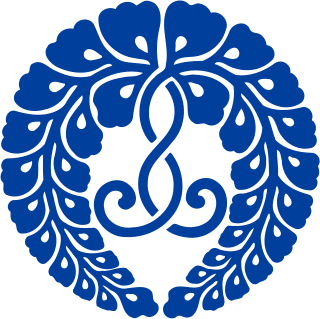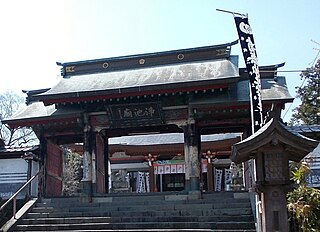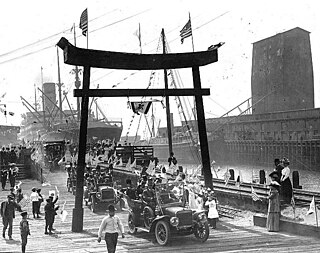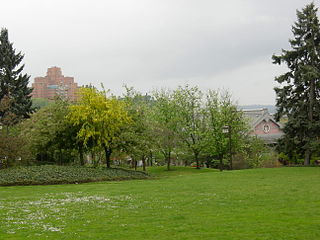
Nichiren Buddhism, also known as Hokkeshū, is a branch of Mahayana Buddhism based on the teachings of the 13th-century Japanese Buddhist priest Nichiren (1222–1282) and is one of the Kamakura period schools. Its teachings derive from some 300–400 extant letters and treatises either authored by or attributed to Nichiren.

Wapato is a town in Yakima County, Washington, United States. The population was 4,607 at the 2020 census. It has a Hispanic majority.

A torii is a traditional Japanese gate most commonly found at the entrance of or within a Shinto shrine, where it symbolically marks the transition from the mundane to the sacred, and a spot where kami are welcomed and thought to travel through.

Nichiren Shū is a combination of several schools ranging from four of the original Nichiren Buddhist schools that date back to Nichiren's original disciples, and part of the fifth:

Seward Park is a municipal park in Seattle, Washington, United States. Located in the city neighborhood of the same name, it covers 300 acres. The park occupies all of Bailey Peninsula, a forested peninsula that juts into Lake Washington. It contains one of the last surviving tracts of old-growth forest within the city of Seattle. The park is named after U.S. Secretary of State William Seward.

The Gila River War Relocation Center was an American concentration camp in Arizona, one of several built by the War Relocation Authority (WRA) during the Second World War for the incarceration of Japanese Americans from the West Coast. It was located within the Gila River Indian Reservation near the town of Sacaton, about 30 mi (48.3 km) southeast of Phoenix. With a peak population of 13,348, it became the fourth-largest city in the state, operating from May 1942 to November 16, 1945.

The Buddhist Churches of America is the United States branch of the Nishi Honganji subsect of Jōdo Shinshū Buddhism.

Minidoka National Historic Site is a National Historic Site in the western United States. It commemorates the more than 13,000 Japanese Americans who were imprisoned at the Minidoka War Relocation Center during the Second World War. Among the inmates, the notation 峰土香 or 峯土香 was sometimes applied.
An Inari shrine is a type of Japanese shrine used to worship the kami Inari. Inari is a popular deity associated with foxes, rice, household wellbeing, business prosperity, and general prosperity. Inari shrines are typically constructed of white stucco walls with red-lacquered woodwork, and their entrances are marked by vermilion torii. Both Buddhist and Shinto Inari shrines are located throughout Japan.

The 1940 United States census, conducted by the Census Bureau, determined the resident population of the United States to be 132,164,569, an increase of 7.6 percent over the 1930 population of 122,775,046 people. The census date of record was April 1, 1940.

The Seattle Dojo is located at 1510 S. Washington in the Squire Park neighborhood of Seattle, Washington. It is the oldest judo dojo in the continental United States, having been founded sometime before 1907 in what is today the International District.

Seattle Betsuin Buddhist Temple is a Japanese Jodo Shinshu Buddhist temple in Seattle, Washington, United States. It is a member of the Buddhist Churches of America. Its original name is the Seattle Buddhist Church.
Stuart Falconer Forbes was an American football player and coach. He served as the first head football coach at the University of Arizona, coaching for one season in 1899 and compiling a record of 1–1–1.

Honmyō-ji (本妙寺) is a Buddhist temple of the Nichiren sect, Rokujōmon-ryū (六条門流), in Nishi-ku, Kumamoto, Japan. It is the most high-ranking temple of the sect in Kyushu. In Honmyō-ji is the grave of Katō Kiyomasa, (1562–1611), a Japanese daimyō, builder of Kumamoto Castle and a dedicated buddhist of Nichiren Buddhism.
Keplar Barth Johnson was an American architect and a member of the American Institute of Architects. From 1937 to 1962, he was the Region 5 Architect for the U.S. Forest Service.

There is a population of Japanese Americans and Japanese expatriates in Greater Seattle, whose origins date back to the second half of the 19th century. Prior to World War II, Seattle's Japanese community had grown to become the second largest Nihonmachi on the West Coast of North America.

The architecture of Seattle, Washington, the largest city in the Pacific Northwest region of the U.S., features elements that predate the arrival of the area's first settlers of European ancestry in the mid-19th century, and has reflected and influenced numerous architectural styles over time. As of the early 21st century, a major construction boom continues to redefine the city's downtown area as well as neighborhoods such as Capitol Hill, Ballard and, perhaps most dramatically, South Lake Union.
Saunders and Lawton was an architectural firm consisting of partners George Willis Lawton and Charles Willard Saunders active from 1898 until 1915 in Seattle, Washington. Other architects at the firm included Herman A. Moldenhour, Paul David Richardson, and J. Charles Stanley. Following Saunders' retirement, Moldenhour would take his place as partner in the firm under the name Lawton & Moldenhour, who would have moderate success throughout the 1920s.

Broadway High School, originally known as Seattle High School, opened in Seattle, Washington in 1902 and was the first dedicated high school built in Seattle.

Wisteria Park is a park in Seattle's Central District, in the U.S. state of Washington. The private parkland is across from the Seattle Betsuin Buddhist Temple and has a bonsho.

















